Digital Doc IRIS Camera Setup Guide
This guide describes the installation and setup of the Digital Doc IRIS intraoral camera for use with Dentrix Ascend Imaging.
Last updated: 10/31/2025
Overview
Dentrix Ascend Imaging supports the acquisition of intraoral images from the Digital Doc IRIS camera on a computer running the Windows operating system.
Notes:
-
Prior to the installation of the camera, the acquisition agent application must be installed on each computer that will acquire images. Refer to Setting up the acquisition agent for instructions on downloading and installing the acquisition agent.
-
The Digital Doc Iris camera will only work properly via direct integration with a 32-bit installation of Google Chrome. If you cannot use 32-bit Chrome, it is recommended that you install the TWAIN drivers instead of the drivers for direct integration.
Installation
Drivers for the Digital Doc IRIS camera must be installed on each computer that the camera will be plugged into.
Note: If a Digital Doc IRIS camera was installed and operating previously with this computer, and you plug the camera into a USB port, Windows will not search for drivers because they are already installed; in this case, you can ignore these installation instructions and skip directly to the "Testing" section of this guide.
To install the drivers, do the following:
-
Start the Digital Doc IRIS driver installer as an administrator. (The installer for 64-bit Windows is IrisSetup_1.3.34.exe.)
The Welcome screen appears.
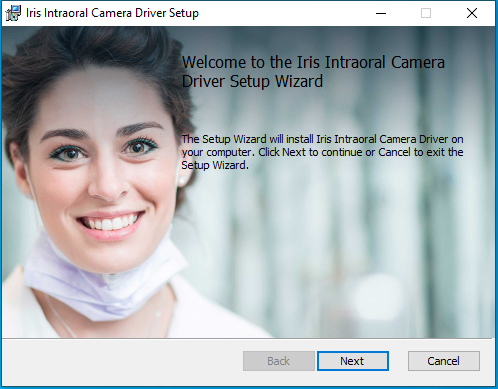
-
Click Next.
The End-User License Agreement screen appears.
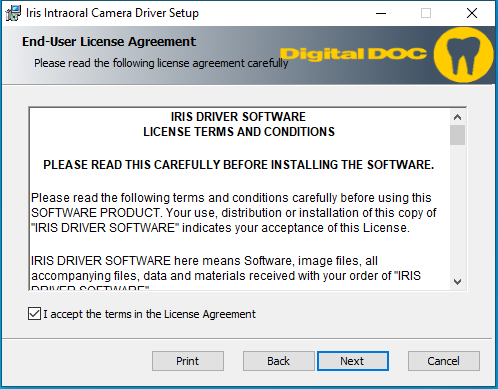
-
Select the I accept the terms in the License Agreement checkbox, and then click Next.
The Destination Folder screen appears.
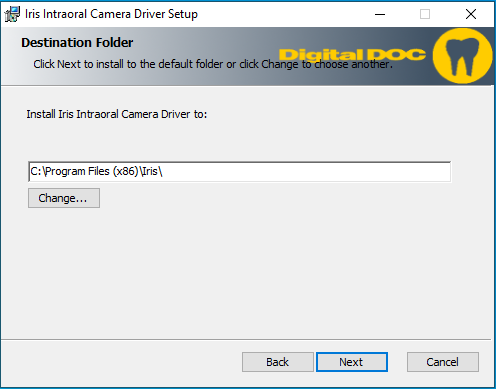
-
Select where to install the camera drivers, and then click Next.
The Dental Imaging Software screen appears.
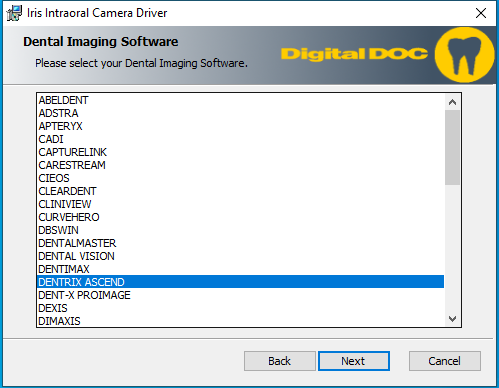
-
Select DENTRIX ASCEND, and then click Next.
The Ready to install screen appears.
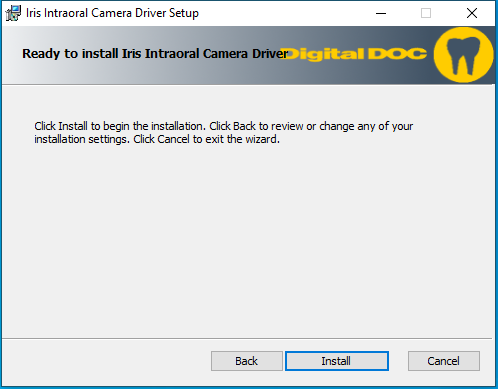
-
Click Install.
-
On the Windows Security messages that appear, click Install.
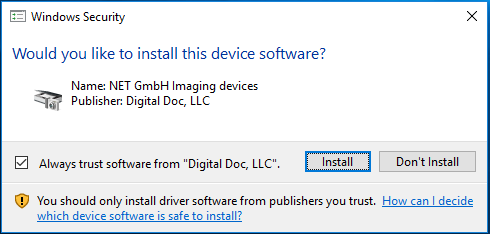
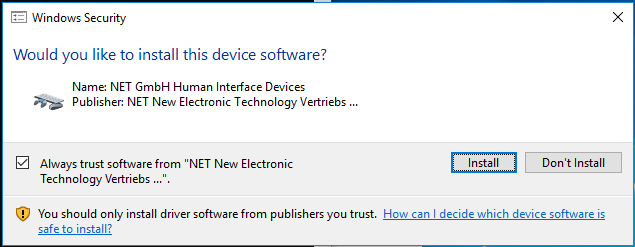
-
On the message, regarding attaching your device, that appears, click OK.
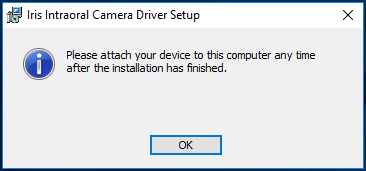
When the installation is complete, the Completed screen appears.
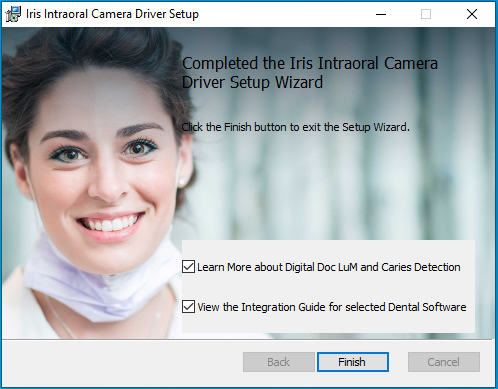
-
Click Finish.
-
To prevent technical issues in the future, connect the camera to every USB port on the computer. This is to ensure that the device will be recognized no matter which port it is plugged into.
Note: The Digital Doc IRIS camera driver installer also installs a virtual game port device (a fake joystick). Game Port 0, which is the default game port on a computer, is usually configured for use with the camera. Dentrix Ascend Imaging recognizes button pushes on the camera according to the Joy Number, which is 0 by default, in the acquisition agent preferences (click the Acquisition Agent icon in the system tray, and then select Preferences). You may need to update this preference if the buttons do not work while you are acquiring an image in Dentrix Ascend Imaging. If you need assistance with determining which joystick port is being used or with troubleshooting camera button issues, contact Digital Doc Support.
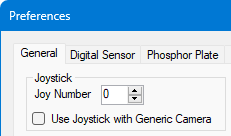
Testing
The Digital Doc Iris camera is now functional in Dentrix Ascend Imaging. To acquire a test image, do the following:
-
Select the 2D Oral/Facial Photo Images imaging procedure.
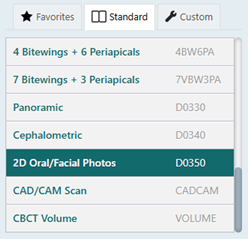
-
On the Available Devices menu, select Digital Doc Iris / Iris HD.
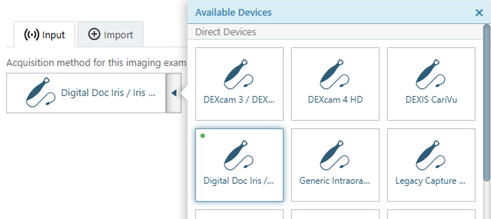
-
Click Start.

Notes:
-
If a message about the browser not being able to access the camera appears, refer to the steps in the "Troubleshooting" section of this guide.
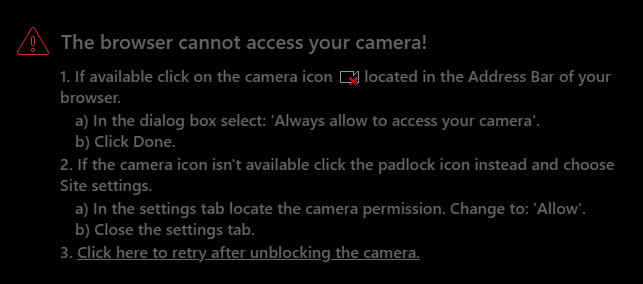
-
To access basic camera settings, click the cog icon (in the upper-right corner of the snapshot panel).

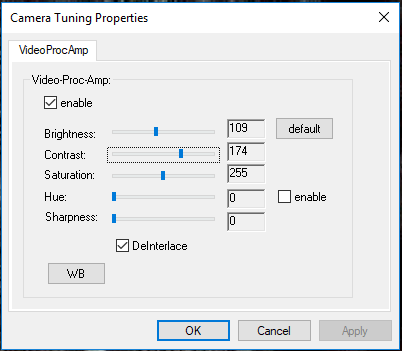
-
-
If there is more than one camera connected to the computer, or if the computer has a built-in webcam, Google Chrome may not select the intraoral camera by default. If this happens, to select the correct camera, do the following:
-
Click the camera icon (in the upper-right corner of the snapshot panel).

-
Select the option that corresponds to the correct camera, and then click Change Source.
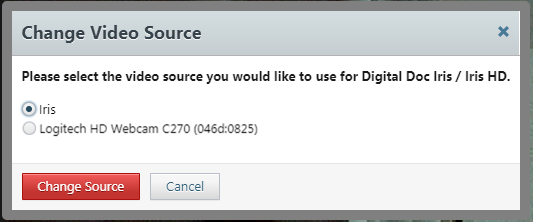
Note: You may need to be restart the browser for the changes to take effect.
After you have configured the camera and started an acquisition, a live video stream from your camera appears.

-
-
With the camera properly positioned, use the button on your camera to pause or freeze the live video stream (or click Pause Streaming).

-
Use the button on your camera to capture the current video frame (or click Take a snapshot). The resulting image is added to the snapshot panel, and the video stream automatically becomes live again.

-
Repeat steps 5-6 as needed to acquire additional snapshots.
-
On the snapshot panel, clear the check box of the snapshots that you do not want to save.

-
Click Assign Images.
-
Do any of the following:
-
To save one or more snapshots as intraoral images and assign tooth numbers, select the snapshots that pertain to the same teeth (deselect snapshots that do not pertain to the same teeth), and then drag them to the Select Teeth, UR/UL/LR/LL, Upper Jaw, or Lower Jaw box.

If you drag snapshots to the Select Teeth box, select the applicable teeth, and then click Assign Teeth.

-
To save one or more snapshots as extraoral images, select the snapshots that are extraoral images (deselect snapshots that are not extraoral images), and then drag them to the Extraoral Photos box.

-
To save the snapshots on the snapshot panel as intraoral images, but not assign tooth numbers, leave those snapshots on the snapshot panel.
Assigned intraoral images appear on the left side of the preview area; extraoral on the right.

Note: If you have a mix of intraoral and extraoral images, they map to one procedure (D0350), which will appear in the progress notes with two icons. Also, you can delete or reassign the intraoral or extraoral exam as needed in the future.
-
-
Click Begin Uploading.
Troubleshooting
Camera Device Drivers
To confirm that the camera device driver is loaded and recognized by Windows, do the following:
-
Plug the camera into a USB port.
-
Open Device Manager.
-
Expand the Imaging Devices category, and make sure that the camera is listed ("Digital Doc IRIS x64" or "Digital Doc IRIS x32").
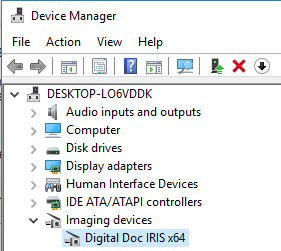
-
If your camera is not being detected by Windows, or if it appears with an error message, try unplugging the camera and plugging it into another USB port on the computer. If the problem persists, contact the camera manufacturer for additional assistance.
Notes:
-
If a driver was installed previously by Windows Update instead of the proprietary Digital Doc IRIS driver, the camera will be listed as a USB 2860 Device in Device Manager, and it may be displayed in a category other than Imaging Devices. In this case, install/re-install the Digital Doc IRIS drivers. If that does not resolve the issue, you may need to update the driver manually from Device Manager.
-
The Digital Doc camera driver installer installs a Refresh Driver utility. If you are having trouble getting the driver to show properly in Device Manager, try running the utility (a shortcut is located in the Digital Doc folder on the Windows Start menu).
-
The Digital Doc IRIS camera buttons will not function properly unless the correct device name appears in Device Manager.
Blocked Camera
If the browser cannot access the camera, an error message appears in Dentrix Ascend Imaging.

To unblock the camera, do the following:
-
In Chrome, click the View site information button on the left side of the URL box.

-
Select Site settings.

-
Change the Camera setting from Ask to Allow.

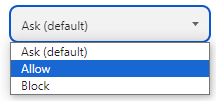
-
On the error message in Dentrix Ascend Imaging, click the Click here to retry after unblocking the camera link.
